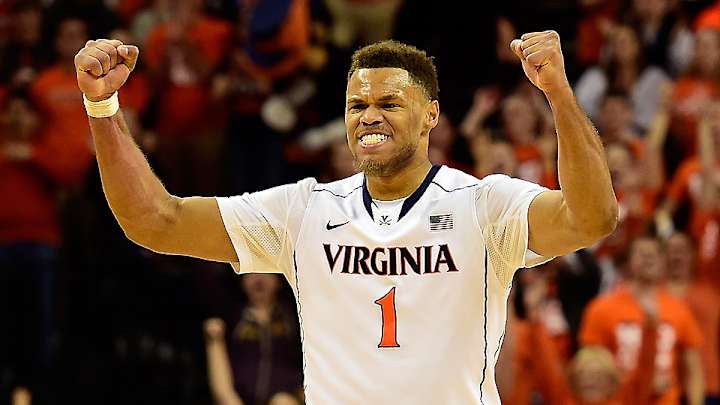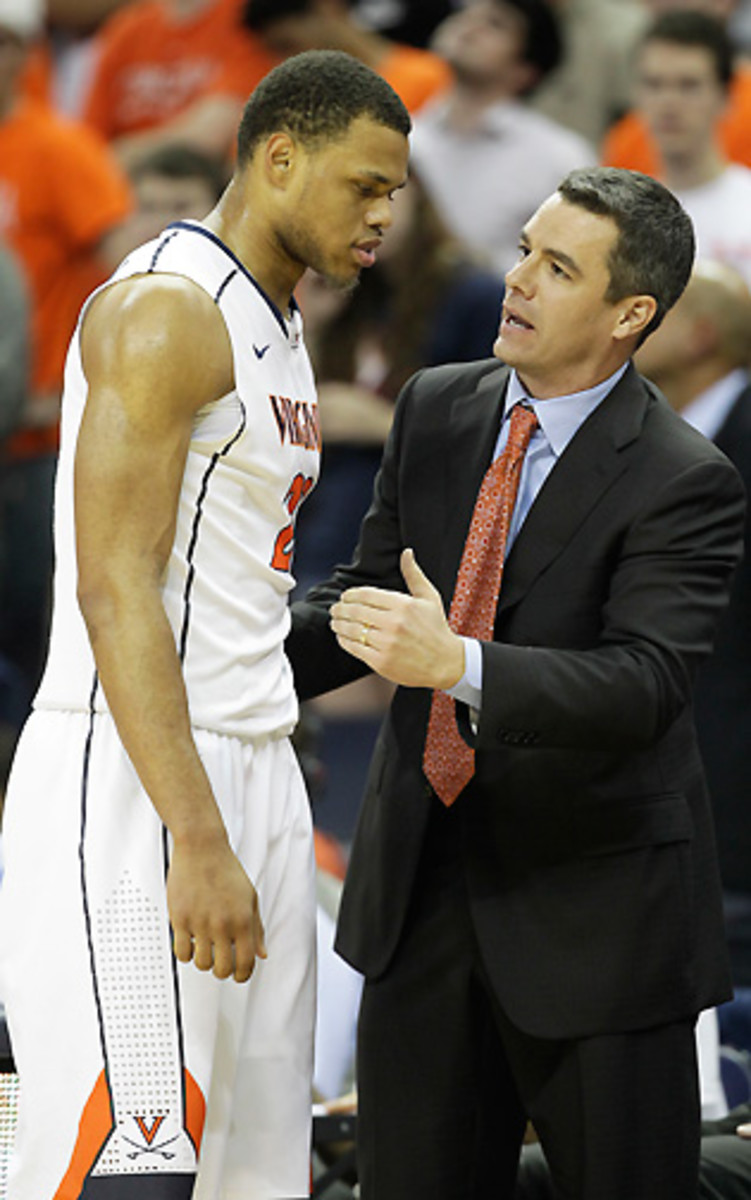Patience, practice propelled Justin Anderson to starring role at Virginia

Justin Anderson vividly remembers that first dunk: He and his father meandered into an auxiliary gym at Washington and Lee University, during a trip to the school to watch Anderson’s older brother, Edward, play for the University of Mary Washington. Anderson and his father began shooting around. At some point, Edward Sr., directed his younger son to get up and flush it through the rim. So Anderson flushed it. He was in fifth grade, when dunking is generally reserved for chicken nuggets and swimming pools.
“It was so cool,” Anderson says now. “The thing is, I tried to go back and show my friends and I kept missing.”
He’s laughing at the memory as he lingers outside a locker room at Notre Dame’s Purcell Pavilion, a fully formed 6-foot-6, 230-pound 21-year-old having led one of the country’s best basketball teams to another win. Had you seen Anderson in that long-ago moment in a Division III gym, you might have expected so much. You would be getting it now: Anderson, a junior, is by at least one measure the most important player for No. 2 Virginia (16-0). He’s a linebacker gliding from spot to spot, the efficient leading scorer for a balanced crew, a propulsive athlete whose improved jumper now makes him infuriating to prepare for.
But Anderson’s path from that gym to here hasn’t been smooth. He became a nationally prominent eighth-grader who labored early at powerhouse Montrose (Md.) Christian School before finishing as a consensus top-50 recruit. He flipped his college choice from Maryland to Virginia after Terrapins coach Gary Williams retired in 2011 and then scuffled as a role player for two seasons with the Cavaliers. It took a summertime epiphany while training in the Chicago suburbs, coupled with more opportunity in Charlottesville, for his production to match his potential.
• MORE CBB: Bracket Watch: Virginia holding firm to a top seed
“You can’t just expect things to just be given to you,” Anderson says. “When I was younger, I think everything was given to me because I was so athletic. People started to tell me how good I was, and I think I started to listen to it. I never worked hard. I maybe got some shots up, played a little pickup basketball. It’s much more than that. You have to make sure you put your work in. You have to make sure you value the little things. There were a lot of life lessons. I could talk about that for days.”
He has a plane to catch, so he can’t, but the results are clear: Career-high rates in points (14.9), rebounds (4.6) and minutes (29.2) per game, plus field goal percentage (53.3) and three-point accuracy (55.7). Anderson’s Win Shares total of 3.5 -- an estimate of victories contributed by his offensive and defensive production -- leads Virginia, topping even All-ACC teammate Malcolm Brogdon (2.6).
“He’s a main guy now,” Notre Dame coach Mike Brey says of Anderson. “He has a confidence and swagger about him. When you have that size, strength and an ability to shoot like that, it’s a really tough matchup for anybody in this league, dealing with him.”
Anderson hadn’t been an afterthought -- he had 22 starts in his first two years and ACC media named him the league’s sixth man of the year in 2013-14 -- but he wasn’t a priority for opponents, either. His recruiting pedigree did not translate to instant collegiate consistency. His uncommon athleticism didn’t excuse him from having to earn coach Tony Bennett’s trust, especially on the defensive end. There were bursts of production along the way, like Anderson averaging a team-high 19 points per game in a three-game 2013 NIT run. Still, what Anderson might do was of limited value, especially compared with what veterans like shooting guard Joe Harris actually did.

Bennett expected Anderson to play like an upperclassmen this season. The coach told his talented guard he didn’t expect perfection. He also didn’t expect excuses. Seize the chance you have, Bennett told Anderson, by acting like you should in all phases. “I always keep challenging him: ‘Be sound and tough, be sound and tough,’” Bennett says. “You just do it the way you have to do it. You don’t have to be Joe Harris, (just) because Joe Harris left. Understand how you help this team. I like the maturity I’ve seen.”
Over the summer, Anderson flew to the Chicago area to visit his cousin, Jermon Bushrod, a tackle for the Bears. Bushrod ferried Anderson to TC Boost, a training facility in Northbrook, Ill. There, Anderson continued Virginia’s offseason conditioning plan while augmenting it with speed and agility drills aimed at honing his footwork and explosiveness. Anderson also observed how Bushrod lived, and recalibrated his own habits. The NFL veteran awoke early and fueled his body with a healthy breakfast, for example, while Anderson often was like many other college kids who steal an extra hour or two of sleep at the expense of the first meal of the day. “He approaches it as work,” Anderson says of his cousin. “I tried to translate that attitude to college basketball -- I want to go to practice as if it’s work.”
A tune-up of Anderson’s basketball mechanics, though, drove his third-year breakthrough. During Anderson’s visit, one of TC Boost’s owners, Tommy Christian, placed a call to a local basketball trainer, Steve Pratt. The owner of Full Package Basketball, Pratt counts Elton Brand, Brad Miller and Thabo Sefolosha among his past clients. He uses biomechanics to examining a player’s shooting form and then to refine it. Christian asked Pratt if he could work with Anderson. Pratt agreed, and that began a crash-course in which Anderson refashioned the jumper that has driven his offensive surge.
Pratt surmised Anderson had too much negative movement in his shot; Anderson pulled the ball back toward his shoulder instead of keeping it over his elbow at a 90-degree angle. (Picture Anderson’s arm in a “V” pre-shot, when it ideally should be an “L.”) Anderson was strong enough to manage that negative movement, but eliminating it would be a positive. “It was a little too slow and a little herky-jerky,” Pratt says of Anderson’s shot. “We wanted to synchronize it.” Pratt also examined Anderson’s balance and coached the player to get his “chest on the rim” -- essentially to land with his chest over his toes after a shot. “It was a lot of technical work that I’ve never seen before in my basketball career,” Anderson says. “It was very taxing on the mind, rather than the body.”
Best offense of Tony Bennett era makes Virginia major title contender
To implement the changes, Anderson did form shooting -- standing still and concentrating on his motion -- all the way back to 25 or 28 feet. He did Pratt’s “Dirk Nowitzki Drill,” in which a player sets his feet in shooting position, squats so that his posterior touches his heels and then raises up into a shot legs-first. It is initially executed slowly, so a player can mentally organize his movements before increasing to game speed.
“It forces you to get your legs into your release,” Pratt says. “A guy like Justin, who is so strong in his upper body, he didn’t have to use his legs. He could just shoot with his arms. But just shooting with your arms, you can be a little inconsistent.”
Before Anderson returned to campus, Pratt told him : You are responsible for your shot. He counseled Anderson to work the shooting stations at Virginia’s basketball camp and to remain diligent on his mechanics. Anderson appears to have followed through. “I would say it deserves a lot of the credit for why I’ve taken my game to the next level,” he says. His career-best shooting percentages support that assessment. As does this: Anderson has spent 32.2 percent of his offensive plays in spot-up scenarios, according to Synergy Sports data, and he’s averaging a striking 1.712 points per possession in those circumstances. More specifically, he’s at 1.791 PPP on no-dribble jumpers out of those spot-up plays.
It has helped expand the best offense of Bennett’s tenure, an egalitarian attack that doesn’t offer defenses many easy answers. Virginia ranks third in adjusted offensive efficiency as of Wednesday, per kenpom.com. Five Virginia players have usage rates between 21.3 and 25.0 percent. Five regulars have effective shooting percentages exceeding 54 percent, with a sixth, Brogdon, checking in at 51 percent. Anderson’s enhanced range and efficiency add another stress point for opposing defenses while alleviating pressure on teammates; no one can slough off him anymore.
“With Justin improving his shooting, he becomes a whole different weapon,” said Clemson coach Brad Brownell, before Anderson scored 15 points in Virginia’s 65-42 win over the Tigers on Tuesday. “He’s certainly as athletic as anybody in the ACC. Now when he’s able to rise up from 22 feet and shoot it in, it extends your defense, it opens things up in the interior for other players, and it creates spacing problems for you defensively.”
• SETH DAVIS: Evaluating the struggles of 10 blueblood programs
Bennett, meanwhile, is as encouraged by what Anderson isn’t doing. The improved shot merits attention, but Virginia’s coach sees Anderson passing up opportunities to search for better ones. He also likes Anderson’s effort output in rebounding and in the team’s asphyxiating pack-line defense. “He’s taken steps in every area,” Bennett says. “It’s like (the line from) What About Bob? -- ‘Baby steps, baby steps.’ His incremental improvements in a lot of areas are significant.”
When Anderson was a nationally ranked eighth-grade prospect he remembers everyone showing him articles he’d already seen and even teachers excitedly talking to him about it. “It was always in my face,” Anderson says. It did him no good. So he had to wait at Montrose Christian, coming off the bench early in his time at a school that produced NBA talent like Kevin Durant, Greivis Vasquez and Terrence Ross. He had to wait at Virginia, mastering structured systems while in a supporting role to trusted veterans.
“Patience,” Anderson says, “was definitely something I had to make sure I stayed aware of.”
Anderson took heed of the little things and has become, arguably, the best player on a team with legitimate aspirations of a run to Indianapolis in April. That first, fifth-grade dunk at a tiny liberal arts school seems like such distant history, given the occasional detours between there and here. But sometimes the best directions are to take the long way.
